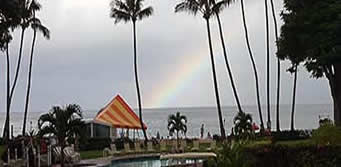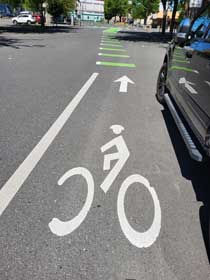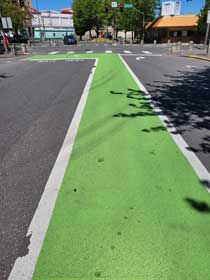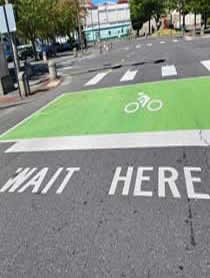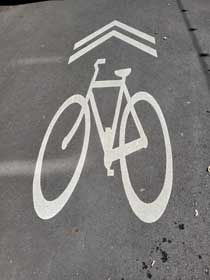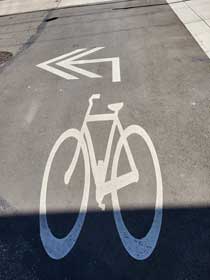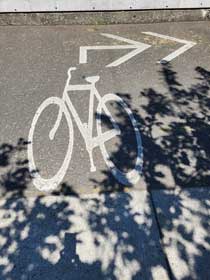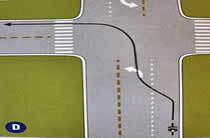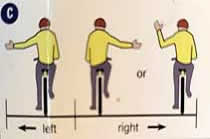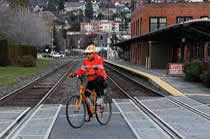| |
|
| |
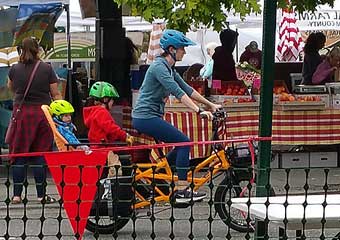 |
|
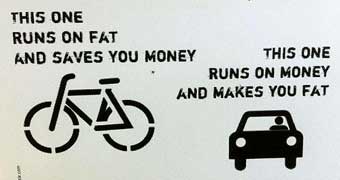 |
|
| |
Doing everyday errands on a bike saves money, helps the climate and gives joy. Photo by Steve Giordano |
|
This sort of speaks for itself.
Image via internet
|
|
With the price of gas continuing to rise and the promise of good weather continuing to emerge, it may be time to consider taking to a bike for everyday errands and refreshing exercise. Here are some helpful tips, a review of safety measures and perhaps even some things you might not have known about biking in the city.
| |
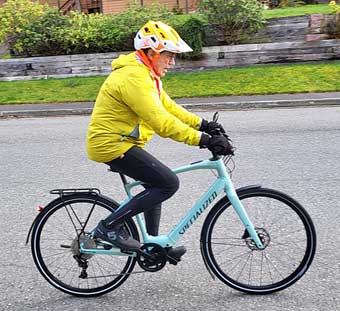 |
|
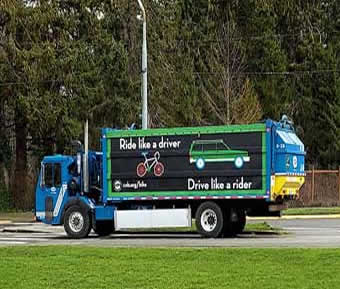 |
|
| |
Always ride with the flow of traffic, never against.
|
|
Ride like a driver. Drive like a rider. This says it for all of us who share the roads.
Photo by Steve Giordano |
|
|
Bicycles are legally defined as vehicles. You may be a bit trepidatious about riding in city traffic, but by obeying traffic laws, you can avoid serious bike/car crashes. Just like motorists, if you break traffic laws, you’ll be subject to penalty fines. Be sure to observe these important laws for safe road cycling, especially in the city.
*Ride in the same direction as motor traffic.
*Stop for pedestrians in crosswalks.
*Yield to people walking on trails.
*Do not ride on sidewalks in a business district.
*Do not use headphones or other electronic devices while cycling on roads or trails.
*Use a bike bell or a friendly voice to warn others when approaching from behind.
*Observe what is called “the Idaho stop” rule at stop signs and traffic signals.
Let’s clarify exactly what this 2020 Washington law means. The “Safety Stop” or "Idaho Stop" law allows bikers to treat most stop signs as yield signs, with a few exceptions. People biking must still slow down, look around, and yield to any pedestrians and cars that have entered the intersection. If there’s no one around, the bike can proceed. Bikers must, however, still come to a full stop at traffic lights, stop signs on school buses and railroad crossings. Also relevant for bikers, the “Dead Red Bill” allows people on bikes, motorcycles and mopeds to safely move through the traffic light intersection if an entire cycle passes without giving a green light to that rider. Arkansas, Delaware, Oregon and Idaho have similar measures on the books.
Some communities, such as Bellingham, WA, are creating connected networks to encourage safe biking by painting graphics and markings as well as installing bike detectors on their city streets.
| |
Graphics show bike lane merging into the safe green bike zone. |
|
The safe green bike zone leads into the intersection ahead. |
|
Bikes wait inside the green box, cars wait behind them.
|
|
Bicyclists wait in the green box ahead of traffic. Motorists stop behind the box. This makes bikes more visible and their intentions more predictable to drivers.
| |
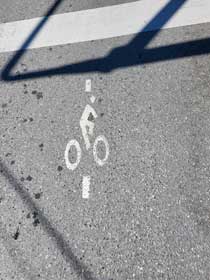 |
|
This graphic signifies that an electronic bike detector has been installed under the road surface that will trip the traffic light when a bike is ridden over it. If there is no symbol, the lawful and predictable approach is to position your bike in the center of the lane, two feet behind the stop bar. |
|
| |
|
|
|
|
Helpful graphics like these help both the motorist and the biker to safely share the road.
Known as “sharrows,” these markings guide bicyclists to the safest place on the street to ride and help motorists expect to see and share the lane with bikers. These graphics are also markers along a bike route and designate appropriate and safe directions for the city biker.
Before you start your city bike ride, plan routes with a preference for wide shoulders or bike lanes and low traffic areas. Check your ABCs - your air, brakes and chain. Also be sure to check your quick release levers on your tires to make sure your bike is safe to ride. This may sound like overkill, but I consider myself a really careful biker and on one recent ride, I found that my front quick release lever had been knocked loose during a transition and my front tire could’ve fallen off had I not stopped to check its wobble.
Using a solid U-shaped metal and/or strong cable lock, secure your bike to a rack or permanent post even when you make short stops. Bike theft is definitely on the increase nationwide, especially e-bike theft, so be smart. Lock your bike. One of the first things you should do after buying your bike is to register it with your police department. In Bellingham, WA, this program is accessed at Project529.com and could help you recover it if stolen.
| |
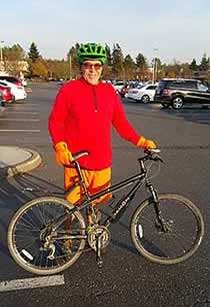 |
|
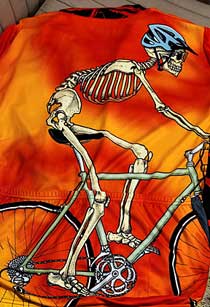 |
|
Brightly colored (sometimes humorous) bike clothes
could save you from an unpleasant crash.
One of the most important things for city bikers is visibility. I am always, always astounded to see so many bikers dressed all in dark, dull clothes without any lights on their bikes - front or back. Wear brightly colored clothes and turn on your lights - a bright white headlight on the front and a red tail light - especially at night and even during the day to give motorists a break. Reflective bands and clothing also help send a visual signal that you and your bike are present.
Wear protective gear - a properly fitted helmet, gloves, and eye protection, all of which will help to reduce injuries if you’re in a crash. Prepare for wet weather, especially in the Pacific northwest. Dress appropriately in waterproof and brightly colored clothing, and allow for longer stopping distances on wet pavement.
Give motorists every opportunity to see you. Ride on the right with the flow of traffic and be visible by positioning your bike in the right third of the lane. Do not hug the curb or pass cars on the right.
Ride in the middle of the lane when necessary. When lanes are too narrow to share, ride in the middle as a signal that motorists should cross into the next lane to pass you as they would for another vehicle. When riding along a row of parked cars, ride in the middle of the lane - at least three feet from the cars - to avoid colliding with suddenly opened doors.
Avoid riding on sidewalks, especially in city business districts. This endangers people walking on sidewalks and puts cyclists on a collision course with turning motorists.
Most bicycle/car crashes happen at intersections. Cyclists can prevent most of them by obeying traffic laws and riding defensively. Be mindful about communicating your intent to motorists. Use your position in the lane as a signal of your intended direction. Be bold - take your space.
Safe riding means preparing for your adventure, being aware of your surroundings, staying visible, careful, and knowing and obeying traffic laws. Cyclist photo courtesy Cascadia Daily News
When preparing to turn left, position yourself in the left part of the lane or in the lane that cars use to make left turns. To turn right, approach the intersection in the middle of the right lane. If you’re going straight, also move to the center of the lane. Look back over your shoulder to check traffic and yield before signaling a turn. Use hand signals to indicate turns - left arm straight out to turn left, right arm straight out or left arm bent up to turn to the right. Make eye contact if possible as a driver’s view may be obstructed by other vehicles, signs, mirrors or door posts. Be aware of blind spots or possible sun shining in a motorist’s eyes and be prepared to slow or stop when making turns. Just be aware.
Be aware and beware of roadway hazards like parked cars, slippery surfaces - gravel, wet leaves, sand, steel plates, potholes, debris and broken glass. If you have to cross railroad tracks, check traffic, signal, pull out into the lane so that you can cross with your wheels at right angles to the tracks. Getting a tire wedged in a track gap can cause a nasty crash.
Lots of information to digest, but the more you practice safe, mindful riding and become more comfortable handling your bike - new rider or veteran - the more safely and courteously you and motorists around you will operate in sharing the road.
Basic Bike Check ABC
Bike Helmets
Start/Stop
Sharing the Trail
Riding on the Sidewalk
Signaling
Where on the street to ride
Intersection Positioning
The League of American Bicyclists has produced a number of short videos that demonstrate the above principles of safe city biking. These are all available on the Whatcom Smart Trips website at this link:
https://www.whatcomsmarttrips.org/safety_videos
| |
Kirsten Wert, Smart Trips Program Coordinator, offers professional, personalized, fun and free bike classes where and whenever it’s convenient for you in the Bellingham, WA, area. She has a wealth of information and valuable tips to share. |
|
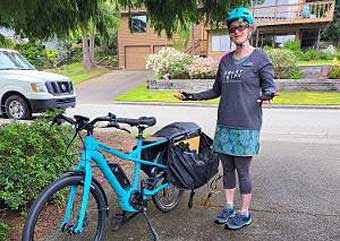 |
|
Some cities have excellent bike programs with classes offering instruction to all levels of riders. Bellingham, WA has such a program called Whatcom Smart Trips, https://www.WhatcomSmartTrips.org/bike-classes. Their classes range from Learn to Ride to Family Class to E-Bike Riding, are all delightfully and safely taught by veteran cyclers to match your needs and - they are all free. You can visit their website to schedule a time for your next adventure.
About the Author
| |
Lynn Rosen is an Emmy award-winning TV broadcaster, producer and director, and has been on the Journalism and Theatre faculties at Western Washington University in Bellingham, Wash. She’s also a theater critic, travel writer, published author, fearless skier and belongs to the American Theatre Critics Association (ATCA) and the Society of American Travel Writers (SATW). |
|
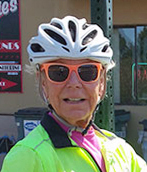 |
|
|
|
|
